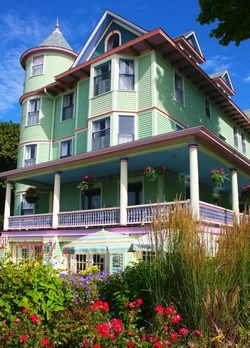The Native American History of Mackinac Island: What Every Visitor Should Know
Introduction
When people think of Mackinac Island, they picture fudge, horses, and bikes. But long before tourists arrived, the island had a deep spiritual history. Native American tribes lived, gathered, and told stories here for centuries. This post explores that history and why it’s important today. If you love Mackinac Island, learning its Native past adds more meaning to your visit.
The First Inhabitants: Anishinaabe Presence
The earliest known people on Mackinac Island were the Anishinaabe. This group includes:
- The Ojibwe (Chippewa)
- The Odawa (Ottawa)
- The Potawatomi
Together, they formed the Three Fires Confederacy, a strong cultural alliance. These tribes traveled across the Great Lakes and saw the island as a special place. They gathered on Mackinac for trade, storytelling, and sacred ceremonies.
The Anishinaabe believed in living close to nature. They fished in the surrounding waters. They respected animals, plants, and the land. Their culture still lives on today through their descendants across the region.
Sacred Significance of the Island
Mackinac Island wasn’t just a place to live. It held spiritual meaning. The name “Michilimackinac” means “Great Turtle” in the Ojibwe language. That’s because the island’s shape reminded early people of a turtle’s shell.
According to local legend, the island rose from the back of a giant turtle. This story was part of the Anishinaabe creation story. It helped explain the world and their place in it.
The island was also believed to be a bridge between worlds. It was a place where the spirits could visit the living. Many tribes came here in the summer months. They held ceremonies and offered thanks to nature.
Even today, Native people visit Mackinac Island for spiritual reasons. Visitors should treat the land with care and respect. It is more than just a vacation spot — it is sacred ground.
Cultural Life and Historical Turning Points
Trade, Fishing, and Daily Life Before Colonization
Before European contact, Native people thrived on Mackinac Island. The waters provided fish. Forests offered berries, herbs, and game. The Anishinaabe lived in harmony with the land.
The island was also a hub for trade. Tribes from across the Great Lakes came here. They traded furs, tools, beads, and food. These exchanges built strong alliances between communities.
Life on the island was guided by the seasons. In warmer months, families camped near the shore. They fished, gathered plants, and held social events. In colder months, many returned inland to hunt and shelter.
The Anishinaabe:
- Cooked over open fires
- Built homes from bark and animal hides
- Used birchbark canoes to travel the waters
Their connection to nature was strong. They believed all things had spirit — trees, animals, and even water.
Impact of European Contact
In the 1600s, French explorers and missionaries arrived. They brought tools, cloth, and weapons — but also new diseases. Many Native people died from illnesses they had never faced before.
The French also built missions and fur trading posts. Jesuit priests tried to convert tribes to Christianity. Some Native families joined missions; others kept their own beliefs.
The fur trade changed the economy. Beaver pelts became valuable goods. Native hunters worked with French and later British traders. This created new alliances, but also tensions.
As more Europeans came, Native land and freedom shrank. The British replaced the French in the 1700s. Fort Mackinac was built to protect trade routes. Soon, Native control of the island faded.
Treaties, Land Loss, and Cultural Displacement
By the 1800s, the U.S. government pushed for land treaties. Many were unfair or signed under pressure. These treaties forced tribes to give up Mackinac Island and nearby areas.
Some Native families stayed, but many were forced to move west. Sacred places were claimed for forts, homes, and shops. Native voices were pushed aside in the name of growth.
Still, the Anishinaabe resisted. They kept their stories, languages, and traditions alive. Today, their descendants continue to share that proud heritage.
Modern Legacy and Visitor Awareness
Present-Day Native Connections to Mackinac Island
Native American culture remains a living part of Mackinac Island. While the land has changed, its spiritual meaning still stands strong. Many Anishinaabe people continue to honor the island today.
Some tribal members return each year for prayer and tradition. The island is still viewed as a sacred space — not just a tourist stop. Though tribes may not live directly on Mackinac anymore, their roots are deep and lasting.
Nearby Native communities, such as the Sault Ste. Marie Tribe of Chippewa Indians and Little Traverse Bay Bands of Odawa Indians, keep those ties alive. They host:
- Storytelling events
- Cultural presentations
- Seasonal gatherings and powwows
These moments allow people to reconnect with the island’s original spirit and keep traditions alive for future generations.
How Visitors Can Respect and Engage with This History
Visiting Mackinac Island can be more meaningful when you explore it with care. The land holds more than just natural beauty — it carries history, memory, and spirit. Here are some ways to show respect:
- Walk softly on sacred land. Be mindful in quiet forest areas or near natural rock formations like Arch Rock.
- Learn from Native sources. Read books, watch documentaries, or listen to Native podcasts about Anishinaabe culture.
- Support Native artisans. Look for Native-made crafts, jewelry, and artwork at markets or online.
- Use correct names. Refer to tribes by their proper names, like Ojibwe or Odawa, not just “Native Americans.”
- Ask questions respectfully. If attending a cultural event, show interest without assuming or intruding.
Understanding the stories of the island’s first people makes your visit richer. You’re walking where generations have prayed, fished, and raised families.
Conclusion
Mackinac Island is more than charming hotels and fudge shops. It’s a place where Native American history and spirit still live. As a visitor, you can honor this past through curiosity, respect, and support.
When you walk the island’s paths, remember — you walk on sacred ground. Take that knowledge with you, and share it with others. The more we know, the more we care — and caring keeps history alive.
To truly appreciate the island’s peaceful spirit, stay at the Inn on Mackinac. It offers comfort, charm, and easy access to the island’s rich history.
Category: Mackinac Island


